Lissa Johnston's Blog, page 25
September 1, 2015
It's Official: I'm Engaged
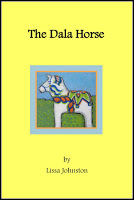 My babyNow that the baby is birthed, I've decided to get engaged. Before you start your pearl-clutching, let me explain. Since I'm far too old to reproduce biologically (thank the heavens), it should be obvious to all that the 'baby' I am referring to is my latest book. And since it's my first time self-publishing, that means I don't get the writer's version of maternity leave - that post-publication downtime when I toss my working files into a drawer and do that wonderfully evocative brushing-of-the-hands gesture (BOTH). Nope. As with producing a human baby, the birthday is only the beginning. Now it's time to feed and nurture and protect my literary offspring forever and ever amen, otherwise known in the writing biz as Marketing.
My babyNow that the baby is birthed, I've decided to get engaged. Before you start your pearl-clutching, let me explain. Since I'm far too old to reproduce biologically (thank the heavens), it should be obvious to all that the 'baby' I am referring to is my latest book. And since it's my first time self-publishing, that means I don't get the writer's version of maternity leave - that post-publication downtime when I toss my working files into a drawer and do that wonderfully evocative brushing-of-the-hands gesture (BOTH). Nope. As with producing a human baby, the birthday is only the beginning. Now it's time to feed and nurture and protect my literary offspring forever and ever amen, otherwise known in the writing biz as Marketing.Which brings us to my recent engagement.
You may have heard something about building a platform to help you market your book. I like to think of the platform as a PR machine built of the writer, by the writer, for the writer. It's about networking and getting your name out there and making connections. There's a tremendous amount of marketing advice out there for newbie self-publishers. I'm drinking at the fire hydrant of information daily, trying not to drown in the process.
Marketing your new book is not just about creating a presence on Facebook and Twitter and Blogger and what have you. It needs to be a two-way street. It needs to be give and take. To have a meaningful and productive marketing experience, you must Engage.
Think of it this way. Imagine attending a gathering, or party, or convention, or other function where you will have the opportunity to interact with people in person and it is appropriate for you to promote your book in the process. Marketing is hiring someone to walk around the event wearing a sandwich board with a picture of your book on it. Engagement is you, walking around, shaking hands and talking to people about lots of things - their book, your book, your kids, the weather, how cool it is you both used to live in Albuquerque, how the addition of pumpkin flavor to craft beer is a sign of the apocalypse, and so forth.
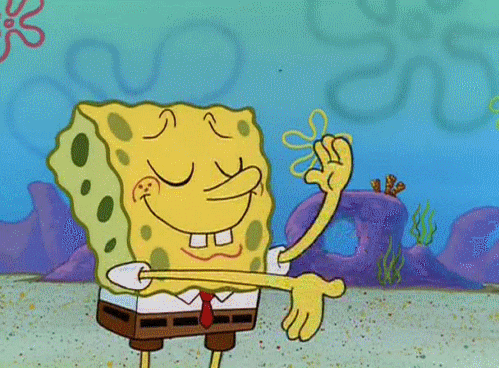 The Brushing Of The Hands (BOTH)I imagine at this point you are trembling with trepidation, because you know what this means. If you are to have meaningful engagement, it's going to take some time. Probably time you don't feel like you have. You might be wondering, why can't I just set up Hootsuite to blast out my perfectly worded Tweet splash every twenty-three minutes ad infinitum until I sell a thousand copies so I can do the BOTH, and leave it at that? I suppose you could. From the looks of my Twitter feed, many of you have chosen to do exactly that. I think of this marketing strategy as the used car commercials of the writing world. And of course that's what programs like JustUnfollow are for.
The Brushing Of The Hands (BOTH)I imagine at this point you are trembling with trepidation, because you know what this means. If you are to have meaningful engagement, it's going to take some time. Probably time you don't feel like you have. You might be wondering, why can't I just set up Hootsuite to blast out my perfectly worded Tweet splash every twenty-three minutes ad infinitum until I sell a thousand copies so I can do the BOTH, and leave it at that? I suppose you could. From the looks of my Twitter feed, many of you have chosen to do exactly that. I think of this marketing strategy as the used car commercials of the writing world. And of course that's what programs like JustUnfollow are for.As in real life, true engagement takes a whole 'nother level of commitment. You have to buy the flowers and remember the birthdays and watch television programs together that you would never otherwise watch. You have to subscribe to blogs and comment on posts. You have to share and Like and retweet and read and review.
Primarily I use Twitter, Facebook and more recently Goodreads (more about that in a future post) for engagement. I'm learning to use them in concert. For example, use the handy feature that automagically invites friends and followers from other social networks as well as your email contacts. This is a great way to broaden your outreach, but is a little too sterile to qualify as engagement. You have to take it a few steps further. Once you have built up your friends/followers, reach out to them individually. Visit their profile and spend some time scrolling through. If you see something that genuinely interests you, say so. If it's worth a share or a retweet, do it. Here's some examples of how to take your engagement level from *yawn* to Yowza!
Ho Hum: hit the Like button
Passable: hit the Like button and leave a comment
Next Level: hit the Like button, leave a comment, and share it publicly to your page
Ho Hum: mark a tweet as Favorite
Passable: Retweet
Next Level: Retweet with a comment and/or reply to the sender to start a conversation
Goodreads
Ho Hum: add your FB and Twitter friends/followers on Goodreads
Passable: add your friends' book to your Want To Read list
Next Level: actually read their book and Review it (extra points for sharing your review at Amazon as well)
A word to my fellow introverts who are viewing this engagement thing as about as enjoyable as being forced to make small talk with the strangers at your table when you're a plus-one wedding guest: this too shall pass. Sure, you may get ignored. So what? Wouldn't be the first time, would it? But as the great Wayne Gretzky says, you miss 100% of the shots you don't take. Put yourself out there, start engaging, and I guarantee you the positive results will far outweigh the negative (in fact, one early positive interaction will be the focus of my next blog post). It won't be long before you, too, will start to feel fully engaged.
Published on September 01, 2015 10:02
August 6, 2015
It's Self-Published, And It's Magnificent
Drum roll, please: on July 17, 2015, I achieved a personal goal by a) completing my first fiction manuscript, and b) successfully navigating the self-publishing process.
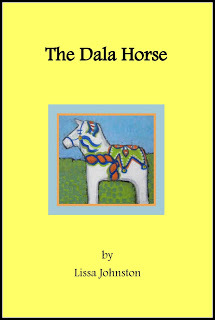 Available for Amazon Kindle
Available for Amazon Kindle
Both are goals I have been working toward for some time. Now that I see how the process works, I have several more works in progress that can hit the e-shelves as soon as I finish them off. As a self-publishing newbie, I thought I would share my experience with the nuts and bolts of it for those of you who are considering doing the same.
Composition
I have been working on this book for a shamefully long time. Originally I began composition using Word 97. I transitioned to OpenOffice, which also worked great. I had a short-lived experience with Google Docs which I don't recommend for longer documents. Let's call that a learning experience aka FAIL. No harm done, thank goodness - I kept the .doc file somewhere safe and was easily able to go back to using it. Earlier this year I saw some references to the Scrivener word processing product. Specifically I was interested in what several users had to say about the ease of converting your manuscript to a format used by the major e-book publishers. I also liked some of its organizational features. Long story short, I bought it and used it and love it. I run it on a PC, so it's not even running full bore (apparently it works best on Mac products) and I really enjoy using it. Although - full disclosure: I am a computer nerd and enjoy the inevitable little puzzles and problems that come up from time to time. The compilation process was no exception. If you don't enjoy troubleshooting computer programs, you may find a few bumps in the road when it comes time to publish. But I think you might experience that regardless of whether you have Scrivener compile your file or let the e-pub sites do it for you.
Editing
I have seen all the advice out there to hire out the editing. I was very tempted to do so, and may do so in future if budget allows. But as luck would have it, Janice Hardy's Fiction University was running her 30-day editing series earlier this spring. As a devout DIY-er, I jumped on board. If only I could have completed the job in 30 days! It was a very grueling couple of months, not gonna lie. I have much to learn on the grand concepts of writing such as plot development and story arc. If I ever hire an editor, that's what I will be looking for help with. But I have a decent grasp of grammar and spelling. Couple that with spell checking technology and St. Janice, and I felt confident my manuscript was in pretty good shape when I pushed the Publish button - as good or better than many I have seen.
The Cover
I have also seen some wonderful advice regarding cover design. I will definitely be applying it to my next project which at present has absolutely no concept for a cover. I especially like this site for DIY designs. But some time ago I happened upon the most adorable piece of art on Etsy that I thought perfectly evoked the tone of The Dala Horse. I contacted the artist, bought the piece, and secured her gracious permission to use it on the cover. I am very happy with the look and really never considered using anything else. I do need to improve my photo editing skills as the image looks a little grainy depending on what I am using to view it.
Publishing
At last the finish line came into view and I started investigating the various self-publishing outlets. I found this article to be particularly helpful, and chose to go with Kindle Direct. It costs nothing up front, it pays well, and the publishing process was fairly straightforward. Presently the book is only available as an e-book. I have no plans to go to the expense of creating it in paper but if I change my mind, it looks fairly easy to do that, also.
Marketing
Part of the reason it has taken me so long to get this project completed is that I allowed myself to use 'building a platform' as an excuse not to work on my manuscript. I wouldn't say a platform is a waste of time, exactly, until I read this eye-opening article by C. S. Lakin about genre vs. platform. I did purchase KDSpy and you better believe I have already used it to confirm my next project will be in a little better position to market itself when it comes out later this year. Yes, you read that correctly: market itself.
I haven't completely abandoned my so-called platform. I am a Twitterholic. I love the advice on how to use Pinterest to complement your book with lots of fun visuals. I reluctantly returned to Facebook and am actually enjoying working with it as a marketing tool. BTW the jury's still out on whether I should have set up a Page or just use my Profile. I was going to set up a Page, but there is a decent argument by Jane Friedman for using your personal Profile instead. Would love to know what you think. And of course would appreciate the follows on Twitter and FB :)
Ephemera
I had a really hard time deciding when to stop the editing and just publish the damn thing. I still have days when something occurs to me that I would like to change or check on. The nice thing about e-publishing is that if it were a glaring error, I could fix it and upload a new version. But I am resisting tinkering with anything now unless it is something ridiculously embarrassing. It's sort of like the writer's version of empty nest - it feels weird when that part of your life is over, but also very satisfying.
Now that The Dala Horse is live on Kindle, that's by no means the end of the project. As a self-published author, I am also responsible for marketing, marketing, and more marketing. I spend mornings on straight-up marketing (via social networking, mostly) and brainstorming ideas for more marketing. Afternoons are devoted to the new project and the occasional blog post. The two main takeaways from Dala that I am applying to the new project are story structuring/scene maintenance on the front end, which I learned in Janice Hardy's editing program, and the importance of genre positioning (on Kindle, anyway) learned from C. S. Lakin's article above. These two elements combined should make for a smoother and more successful outcome on my next self-pub. I'll let you know before the end of the year.
Note: I have no business relationship with any of the websites or products mentioned here. I just enjoyed using them and thought I would share.
 Available for Amazon Kindle
Available for Amazon Kindle Both are goals I have been working toward for some time. Now that I see how the process works, I have several more works in progress that can hit the e-shelves as soon as I finish them off. As a self-publishing newbie, I thought I would share my experience with the nuts and bolts of it for those of you who are considering doing the same.
Composition
I have been working on this book for a shamefully long time. Originally I began composition using Word 97. I transitioned to OpenOffice, which also worked great. I had a short-lived experience with Google Docs which I don't recommend for longer documents. Let's call that a learning experience aka FAIL. No harm done, thank goodness - I kept the .doc file somewhere safe and was easily able to go back to using it. Earlier this year I saw some references to the Scrivener word processing product. Specifically I was interested in what several users had to say about the ease of converting your manuscript to a format used by the major e-book publishers. I also liked some of its organizational features. Long story short, I bought it and used it and love it. I run it on a PC, so it's not even running full bore (apparently it works best on Mac products) and I really enjoy using it. Although - full disclosure: I am a computer nerd and enjoy the inevitable little puzzles and problems that come up from time to time. The compilation process was no exception. If you don't enjoy troubleshooting computer programs, you may find a few bumps in the road when it comes time to publish. But I think you might experience that regardless of whether you have Scrivener compile your file or let the e-pub sites do it for you.
Editing
I have seen all the advice out there to hire out the editing. I was very tempted to do so, and may do so in future if budget allows. But as luck would have it, Janice Hardy's Fiction University was running her 30-day editing series earlier this spring. As a devout DIY-er, I jumped on board. If only I could have completed the job in 30 days! It was a very grueling couple of months, not gonna lie. I have much to learn on the grand concepts of writing such as plot development and story arc. If I ever hire an editor, that's what I will be looking for help with. But I have a decent grasp of grammar and spelling. Couple that with spell checking technology and St. Janice, and I felt confident my manuscript was in pretty good shape when I pushed the Publish button - as good or better than many I have seen.
The Cover
I have also seen some wonderful advice regarding cover design. I will definitely be applying it to my next project which at present has absolutely no concept for a cover. I especially like this site for DIY designs. But some time ago I happened upon the most adorable piece of art on Etsy that I thought perfectly evoked the tone of The Dala Horse. I contacted the artist, bought the piece, and secured her gracious permission to use it on the cover. I am very happy with the look and really never considered using anything else. I do need to improve my photo editing skills as the image looks a little grainy depending on what I am using to view it.
Publishing
At last the finish line came into view and I started investigating the various self-publishing outlets. I found this article to be particularly helpful, and chose to go with Kindle Direct. It costs nothing up front, it pays well, and the publishing process was fairly straightforward. Presently the book is only available as an e-book. I have no plans to go to the expense of creating it in paper but if I change my mind, it looks fairly easy to do that, also.
Marketing
Part of the reason it has taken me so long to get this project completed is that I allowed myself to use 'building a platform' as an excuse not to work on my manuscript. I wouldn't say a platform is a waste of time, exactly, until I read this eye-opening article by C. S. Lakin about genre vs. platform. I did purchase KDSpy and you better believe I have already used it to confirm my next project will be in a little better position to market itself when it comes out later this year. Yes, you read that correctly: market itself.
I haven't completely abandoned my so-called platform. I am a Twitterholic. I love the advice on how to use Pinterest to complement your book with lots of fun visuals. I reluctantly returned to Facebook and am actually enjoying working with it as a marketing tool. BTW the jury's still out on whether I should have set up a Page or just use my Profile. I was going to set up a Page, but there is a decent argument by Jane Friedman for using your personal Profile instead. Would love to know what you think. And of course would appreciate the follows on Twitter and FB :)
Ephemera
I had a really hard time deciding when to stop the editing and just publish the damn thing. I still have days when something occurs to me that I would like to change or check on. The nice thing about e-publishing is that if it were a glaring error, I could fix it and upload a new version. But I am resisting tinkering with anything now unless it is something ridiculously embarrassing. It's sort of like the writer's version of empty nest - it feels weird when that part of your life is over, but also very satisfying.
Now that The Dala Horse is live on Kindle, that's by no means the end of the project. As a self-published author, I am also responsible for marketing, marketing, and more marketing. I spend mornings on straight-up marketing (via social networking, mostly) and brainstorming ideas for more marketing. Afternoons are devoted to the new project and the occasional blog post. The two main takeaways from Dala that I am applying to the new project are story structuring/scene maintenance on the front end, which I learned in Janice Hardy's editing program, and the importance of genre positioning (on Kindle, anyway) learned from C. S. Lakin's article above. These two elements combined should make for a smoother and more successful outcome on my next self-pub. I'll let you know before the end of the year.
Note: I have no business relationship with any of the websites or products mentioned here. I just enjoyed using them and thought I would share.
Published on August 06, 2015 12:24
July 7, 2015
Fizz and Fizzle: A History of Soft Drinks
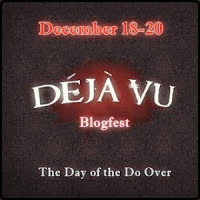 I'm taking part in the Deja Vu Blogfest this weekend. This hop is the brainchild of DL Hammons, who also runs Blog Bitz. The rules of this hop are simple: pick a post from the last 12 months and reblog it. Props to Writeon Sisters for alerting me to this hop and supplying the template for this explanatory paragraph. This post originally appeared in July 2015.
I'm taking part in the Deja Vu Blogfest this weekend. This hop is the brainchild of DL Hammons, who also runs Blog Bitz. The rules of this hop are simple: pick a post from the last 12 months and reblog it. Props to Writeon Sisters for alerting me to this hop and supplying the template for this explanatory paragraph. This post originally appeared in July 2015.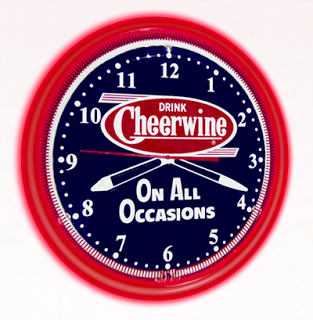 Not to be outdone by Dr. Pepper's '10, 2 and 4' campaign . . .This week's rabbit hole started innocently enough as I enjoyed an article about local foods/drinks that are not easily available outside their home geographic area. The North Carolina beverage Cheerwine was prominently featured. When we first moved to the Carolinas several years ago, Cheerwine had me guessing. Is it wine? If so, why is it sold in a can like beer or soda? Of course the best way to get my questions answered was to try one. Turns out it's a soft drink, or as we say in Texas, it's a coke. Tastes similar to Dr. Pepper but is even sweeter IMO if you can imagine such a thing. Fruity, hint of cherry, hence the name. I've always been curious about that name, so close to what it actually is, but just a little off (like using the Car Fox to shill for the Car Fax product. Still confused about that.). Shouldn't Cheerwine be Cherr Wine as in 'cherry'? But then maybe Chair Wine to get the pronunciation correct, because you know everyone would be pronouncing Cherr 'share'. The problem with Chair Wine is of course that we sacrifice meaning for pronunciation. No one would have a clue what it's supposed to be - is it so awful/amazing, you need to be sitting in a chair to drink it? Obviously way too many issues with Cherr/Chair, so they went with the next best thing: Cheer. That still doesn't explain the 'wine' part. . .
Not to be outdone by Dr. Pepper's '10, 2 and 4' campaign . . .This week's rabbit hole started innocently enough as I enjoyed an article about local foods/drinks that are not easily available outside their home geographic area. The North Carolina beverage Cheerwine was prominently featured. When we first moved to the Carolinas several years ago, Cheerwine had me guessing. Is it wine? If so, why is it sold in a can like beer or soda? Of course the best way to get my questions answered was to try one. Turns out it's a soft drink, or as we say in Texas, it's a coke. Tastes similar to Dr. Pepper but is even sweeter IMO if you can imagine such a thing. Fruity, hint of cherry, hence the name. I've always been curious about that name, so close to what it actually is, but just a little off (like using the Car Fox to shill for the Car Fax product. Still confused about that.). Shouldn't Cheerwine be Cherr Wine as in 'cherry'? But then maybe Chair Wine to get the pronunciation correct, because you know everyone would be pronouncing Cherr 'share'. The problem with Chair Wine is of course that we sacrifice meaning for pronunciation. No one would have a clue what it's supposed to be - is it so awful/amazing, you need to be sitting in a chair to drink it? Obviously way too many issues with Cherr/Chair, so they went with the next best thing: Cheer. That still doesn't explain the 'wine' part. . .But I digress -
So I'm reading this article and my South Carolina hackles rise because we have our own local soft drink here, Blenheim Ginger Ale, so where's the love, dang it?? Blenheim was omitted from the article, but you know I won't leave it out of this blog post.
I did a little poking around and found some interesting stuff about the history of soft drinks. The term 'soft' is to differentiate them from 'hard' drinks, or drinks that contain alcohol. Soft drinks are non-alcoholic (or very low alcohol) and are often, but not always, carbonated and flavored. The soft drink biz is a $50 billion industry (flavoring and manufacturing combined) in the U.S. Yes, billion with a B. Their popularity is linked to many serious health issues including diabetes and obesity. In other words, people can't get enough of the stuff!
The roots of this addictive habit can be traced to ancient times, when naturally carbonated mineral spring waters were prized for their healing properties. It's our nature to believe this stuff is healthy! But in ancient times, no festively decorated 18-wheelers rolled into your village and dropped off conveniently packaged cans of the stuff. If you wanted some, you had to hoof it to the nearest mineral springs, the locations of which may have been the origin for the phrase 'few and far between'. Most folks just were not up for that, considering they were busy avoiding the Mongol hoards, Viking raids, the Black Death, and other delights of bygone eras.
So the trick to enjoying refreshing drinks was either to live near a mineral spring, or find a way to bring the mineral spring waters to you. In 1767, Joseph Priestly made this one step closer to a possibility. If you're thinking he was a master plumber of the Roman aqueduct school, not exactly. Running miles of plumbing pipes wouldn't have worked - the spring water would get flat by the time it arrived at your house. If you're thinking he invented glass bottles, wrong again by over a hundred years. No, what Mr. Priestly came up with was pretty ingenious - he figured out how to add bubbles to plain old water.
 Riker's Drug Store soda fountain New York City 1923Okay, great - now, with the right equipment, we have the potential for creating an endless supply of bubbly water on premises. And that's exactly what businesses did. They set up carbonation rooms and connected the bubbliciousness to a tap. Voila! Fizzy water on demand without all that annoying trekking cross-country to the mineral spring. This was all well and good except for one small problem: the product didn't taste too good. Appetizing ingredients required to create the bubbles such as sulphuric acid, calcium carbonate, and marble dust didn't translate well to the average palate. But not to worry: recall that the early mineral waters were consumed primarily for their purported health benefits, so the natural place to purchase them was at the local pharmacy. Also note: many early medicines were consumed in liquid form. Experienced pharmacists had long been in the business of making yucky liquid medicine taste good enough that their patients would actually take it. If it tastes good, they will drink. Light bulb moment! By the mid 1800s the great experimentation with adding flavors to carbonated water had begun.
Riker's Drug Store soda fountain New York City 1923Okay, great - now, with the right equipment, we have the potential for creating an endless supply of bubbly water on premises. And that's exactly what businesses did. They set up carbonation rooms and connected the bubbliciousness to a tap. Voila! Fizzy water on demand without all that annoying trekking cross-country to the mineral spring. This was all well and good except for one small problem: the product didn't taste too good. Appetizing ingredients required to create the bubbles such as sulphuric acid, calcium carbonate, and marble dust didn't translate well to the average palate. But not to worry: recall that the early mineral waters were consumed primarily for their purported health benefits, so the natural place to purchase them was at the local pharmacy. Also note: many early medicines were consumed in liquid form. Experienced pharmacists had long been in the business of making yucky liquid medicine taste good enough that their patients would actually take it. If it tastes good, they will drink. Light bulb moment! By the mid 1800s the great experimentation with adding flavors to carbonated water had begun.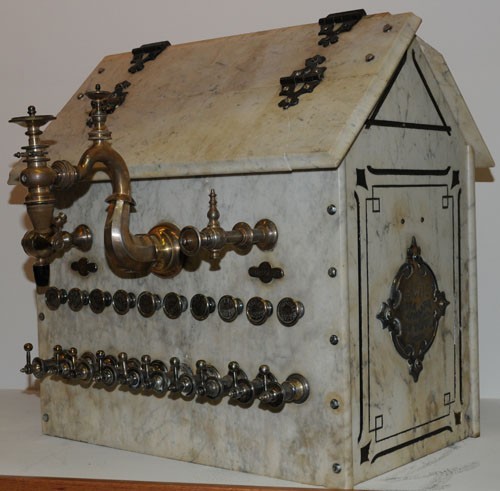 Soda fountains also came in tabletop versions if you
Soda fountains also came in tabletop versions if youcouldn't afford a big production like Riker'sFlash forward to the early 20th century. Soda fountains were popular, but bars were still their primary competition - until Prohibition came along. From 1920-1933, the soda biz exploded (literally as well as figuratively - explosions during the carbonation process were a known hazard). The trifecta of technology (carbonation process), increased demand (due to the addition of appealing flavors), and economics (Prohibition drastically reducing competition from the bar sector) resulted in a boom time for soda fountains. It was very similar to what we are seeing today with craft beers. As with all things, the soft drink boom did not last. Once the bars were back up and running, the soda fountain business flattened out. But a surprising number of these drinks are still around. Many have been gobbled up by conglomerates, but their hometown roots are still there if you look hard enough. Here's a great article listing the local brews from all 50 states.
Some fun facts
Because the soft drink boom was long before artificial colors and flavors existed, many early soft drinks relied on plant-based ingredients such as roots (ginger, sassafras, gentian), vegetables (celery), and fruits (grapes, cherries, lemons, limes) for their flavors. You're probably aware the original recipes for many popular drinks also contained ingredients that are now considered illegal and addictive. After all, Coca-Cola didn't get its name because the inventor had a stammer - it actually did contain a form of cocaine. Around the turn of the century, soft drinks were positioned more as health pick-me-ups, the forerunners of today's energy drinks. Ingredients were often touted to improve health in various ways, and early on, products from the coca plant were considered beneficial. Lithium was also included in some early recipes, notably 7UP, and of course caffeine. Lithium and coca were eliminated when their possible deleterious side effects were discovered. Curiously, the same cannot be said for sugar, high fructose corn syrup, artificial sweeteners, and the various alphabet soup of chemicals currently in many sodas. Maybe some day we will all be reading one of my future blog posts talking about the olden days when people actually enjoyed drinking the gut-destroying concoctions known as 'soft drinks'.
New York entrepreneur John Matthews is known by some as the Father of the Soda Fountain. Not long after he emigrated from England and determined to get into the soda fountain business, the iconic St. Patrick's Cathedral had undergone a recent renovation. Knowing that marble dust could be used in the chemical reaction to create carbonation, Matthews bought up all the crumbled marble. It's estimated the holy scrap fueled 25 million gallons of soda water.
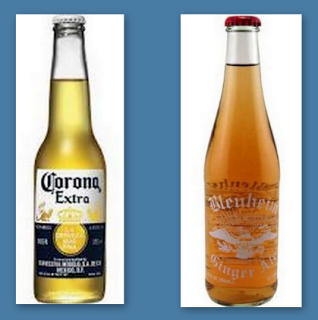 A passing resemblanceGinger ales were far more popular in the early days of soft drinks than they are now. Many contemporary soft drinks available in a variety of flavors today such as Shasta, Polar, RC Cola, and Vernors have ginger ale roots. Literally. Ginger root has been used as a flavoring ingredient and as well as a health aid for thousands of years. When found to flourish in the Caribbean, ginger was readily available in the New World and as such, a natural to make the leap to flavoring carbonated water as well as many other types of food and drink. True ginger ale bears little flavor resemblance to the bland tasting stuff primarily used today as a background for mixed alcoholic drinks. My first Blenheim Ginger Ale was a delightful surprise. If you think you don't like ginger ale, and you have the chance to taste one of these heirloom brews, do it. You'll thank me. Beware the hot versions if you don't like spicy stuff. They're not kidding. Also beware that at a distance, to the South Carolina DNR (boat staties), a clear glass bottle of the golden goodness that is Blenheim looks very much like a clear glass bottle of Corona. . .
A passing resemblanceGinger ales were far more popular in the early days of soft drinks than they are now. Many contemporary soft drinks available in a variety of flavors today such as Shasta, Polar, RC Cola, and Vernors have ginger ale roots. Literally. Ginger root has been used as a flavoring ingredient and as well as a health aid for thousands of years. When found to flourish in the Caribbean, ginger was readily available in the New World and as such, a natural to make the leap to flavoring carbonated water as well as many other types of food and drink. True ginger ale bears little flavor resemblance to the bland tasting stuff primarily used today as a background for mixed alcoholic drinks. My first Blenheim Ginger Ale was a delightful surprise. If you think you don't like ginger ale, and you have the chance to taste one of these heirloom brews, do it. You'll thank me. Beware the hot versions if you don't like spicy stuff. They're not kidding. Also beware that at a distance, to the South Carolina DNR (boat staties), a clear glass bottle of the golden goodness that is Blenheim looks very much like a clear glass bottle of Corona. . .Speaking of beer: the various beer-named soft drinks of course do not contain alcohol, much to every child's chagrin. Who of us didn't feel a guilty pleasure/burst into giggles/think we were more grown up when allowed to have a root 'beer'? Root beer is the foundation for many soft drink dynasties such as Barq's, IBC, and the granddaddy of all root beers, A&W (interesting side note: California-based A&W was America's first franchised restaurant chain and the first restaurant to use drive-in and curbside service. Take that, Mickey D's!) The root used for 'root beer' originally was the sassafras root until one of its components, safrole, was found to be carcinogenic - yikes! Nowadays the safrole is removed from the sassafras compound or an artificial sassafras flavoring is used. This is one of the rare cases when no one will be carping about going back to the original natural ingredient! Sarsaparilla is a close cousin to sassafras, and therefore root beer, in taste if not in taxonomy. Birch beer is flavored with an extract of tree bark, usually birch, and also tastes similar to plain old root beer.
 Grape flavors have also proved popular over the years, as evidenced by Alabama's Grapico,
Grape flavors have also proved popular over the years, as evidenced by Alabama's Grapico, Arkansas' Grapette, and Louisiana's Delaware Punch (which is named for the Delaware grape, not the state). There's nothing like an ice-cold grape soda to give you a temporary but delicious soda mustache.
Arizona's orange-pineapple Cactus Cooler may not have as lengthy a pedigree as some drinks I have mentioned, but it's the only one I found that was inspired by a cartoon (The Flintstones).
Thanks to the bitterness of Maine's local brew's main ingredient, gentian root, it has entered our lexicon as a synonym for 'guts', as in, you have to have plenty of guts to drink it. The name? 'Moxie'.
Michigan's Feigenson brothers weren't pharmacists; they were bakers. Like pharmacists, their profession also lent itself beautifully to the soft drink biz. Icing recipes did double duty as inspiration for the many flavors of their in-house beverage, Faygo. Mmmmmm, icing . . .
 As a kid, I grew up drinking Kool-Aid. One of the few bright spots of being hauled along on the drudgery of grocery shopping trips was being allowed to choose which Kool-Aid flavor packets went into our basket (Black Cherry was my favorite, and yes, my mom used real sugar when she mixed up a pitcher). But Kool-Aid wasn't always sold dry. Back when Kool-Aid was getting its start in Prohibition-era Nebraska, they briefly offered a bottled, carbonated version of the iconic powder mix.
As a kid, I grew up drinking Kool-Aid. One of the few bright spots of being hauled along on the drudgery of grocery shopping trips was being allowed to choose which Kool-Aid flavor packets went into our basket (Black Cherry was my favorite, and yes, my mom used real sugar when she mixed up a pitcher). But Kool-Aid wasn't always sold dry. Back when Kool-Aid was getting its start in Prohibition-era Nebraska, they briefly offered a bottled, carbonated version of the iconic powder mix.New York's Dr. Browns figured out a clever niche for their product. They were one of the few, if not the only, early soft drinks that was Kosher certified. That may be why people continued to drink it, despite the celery they insisted on adding to their flavors. Celery was the hot new health fad once upon a time. Look for a blog post about that here soon.
No treatise on soft drink history would be complete without a mention of Texas' multi-ingredient, cherry cola-flavored Dr. Pepper. DP is one of the few drinks from the soda fountain heydey still going strong today. Invented in 1885 by a pharmacist in Waco, Texas, Dr. Pepper was light years ahead in the marketing game. It got a big publicity bump when it was featured at the 1904 World's Fair in St. Louis. As a Texan, I have a soft spot for DP. Back in the 1970s Dr. Pepper earned my undying devotion when they introduced a diet version. It tasted great! At that time, the only other diet soda available in our area was an abomination known as Tab. Think carbonated cod liver oil. Diet DP was my morning office pick-me-up for years since I'm not a coffee drinker. Envision a hot summer day, walking in from the shimmering asphalt of the company parking lot, greeted by a blast of air frostily conditioned the way only Texans know how, and reach for that chilled bottle of DP straight out of the artic atmosphere of the behemoth coke machine. Heaven!
I don't drink much in the way of soft drinks anymore. I gave up my hardcore forty-year one-a-day Diet Coke/Coke Zero habit in November 2013, thank you very much. At the peak of my addiction, I would scoff at my mom's insistence that cokes just didn't taste the same without the pure cane sugar and the other natural ingredients she remembered from her youth. I was so busy counting calories, I wouldn't have dreamed of drinking a 'real' coke. My, how things have changed. I think that's why I enjoyed that Blenheim ginger ale. So much flavor, without the chemicals in most modern soft drinks that I can taste now that I've kicked the habit. It's definitely an experience I would like to repeat in moderation. What's the best soft drink produced locally in your area? And how can I get some?
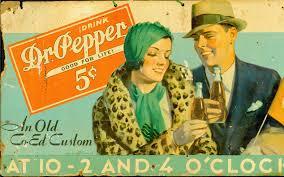
Published on July 07, 2015 08:59



